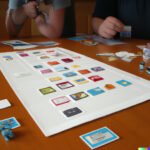The Game of Life Classic Board Game from Hasbro Gaming has been a beloved staple in households for decades. Since its inception, this iconic game has not only provided hours of entertainment but also offered a unique reflection of real-life experiences. In this article, we will delve into the history and legacy of The Game of Life, exploring its origins and impact on board game culture.
First introduced in 1860 by Milton Bradley as “The Checkered Game of Life,” the game has undergone several iterations and updates over the years. From its early roots to its modern-day version, The Game of Life has managed to capture the imagination and hearts of players worldwide. Its longevity speaks to the enduring appeal and relevance of this classic board game.
Throughout the years, The Game of Life has left an indelible mark on popular culture. It has become synonymous with family gatherings, friendly competitions, and bonding moments between friends. As we embark on this exploration of the game’s history and legacy, we will uncover how it has become a cultural touchstone that continues to resonate with players across generations.
How to Play the Game of Life Classic Board Game From Hasbro Gaming
The Game of Life Classic Board Game from Hasbro Gaming is a timeless and beloved game that has been enjoyed by generations of players. If you’ve never played before or need a refresher, here’s a breakdown of how to play this classic board game.
To start the game, each player chooses a car token and places it on the starting space. Players then take turns spinning the spinner and moving their car token along the game board. The goal of the game is to reach retirement with the most money, which is earned through various life events and career choices throughout the game.
Throughout the game, players will encounter different spaces that prompt them to make decisions such as choosing a career path, getting married, having children, buying a house, and more. Each decision can have an impact on the player’s finances and overall gameplay. The player with the most money at retirement wins the game.
If you’re looking for strategies to increase your chances of winning The Game of Life Classic Board Game, consider making strategic career choices that offer high salaries, investing in risky but potentially lucrative ventures, and being strategic about when to take risks versus playing it safe. With its mix of luck and strategy, The Game of Life provides hours of fun for players of all ages.
The Evolution of the Game of Life
Since its introduction in 1860 as “The Checkered Game of Life,” The Game of Life has undergone numerous evolutions and iterations. Over the years, the game has seen various editions and versions, each with its own unique twist on the classic gameplay. From themed editions based on popular movies and TV shows to special anniversary releases, The Game of Life has continued to captivate players with its ever-changing dynamics.
One notable evolution of The Game of Life is the incorporation of modern technology into the game. With the rise of digital gaming, Hasbro Gaming has released various electronic versions of The Game of Life, allowing players to experience the classic board game in a new and interactive format. These electronic adaptations feature enhanced graphics, sound effects, and multiplayer capabilities, providing a fresh take on the traditional gameplay.
In addition to technological advancements, The Game of Life has also evolved in terms of inclusivity and diversity. Recent editions have embraced a more diverse representation of characters and lifestyles, reflecting the evolving societal norms and values. This inclusive approach has been well-received by players worldwide, as it allows for a more relatable and meaningful gaming experience.
| Evolution Highlights | Notable Changes |
|---|---|
| Incorporation of digital technology | Enhanced graphics, sound effects, multiplayer capabilities |
| Embracing inclusivity and diversity | Representation of diverse characters and lifestyles |
The Game of Life Classic Board Game From Hasbro Gaming
The Game of Life has been a staple in many households for decades, bringing families and friends together for a fun and entertaining gaming experience. With its simple yet engaging gameplay, the classic board game from Hasbro Gaming continues to be a family favorite, appealing to players of all ages. The game’s premise of navigating through major life milestones such as college, career, marriage, and retirement resonates with many individuals, making it a relatable and enjoyable pastime.
One of the reasons why The Game of Life has remained a beloved choice for family game nights is its inclusivity. The game can accommodate up to four players, allowing multiple family members or friends to participate at once. This fosters an environment of friendly competition and bonding as players make choices and navigate through the ups and downs of the game’s “life” journey together.
Moreover, The Game of Life promotes social interaction and communication among players. As they progress through the game board, participants have the opportunity to share their experiences and decisions with one another, leading to lighthearted conversations and shared laughter. Families often create lasting memories around the game table while playing this classic board game. Its enduring appeal lies in its ability to bring people together for moments of joy and togetherness.
| Aspect | Description |
|---|---|
| Inclusivity | The Game of Life can accommodate up to four players. |
| Social Interaction | The game promotes communication among players as they progress through the board. |
| Lasting Memories | Families often create long-lasting memories while playing this classic board game. |
The Cultural Impact of the Game of Life
The Game of Life Classic Board Game from Hasbro Gaming has left a lasting impact on popular culture, reflecting societal values, goals, and milestones. The game’s portrayal of life’s journey has resonated with players around the world, making it a timeless classic. Here are some notable ways in which The Game of Life has made a cultural impact:
- Reflection of Societal Values: The Game of Life mirrors the traditional milestones of adulthood, such as getting an education, finding a job, starting a family, and retiring. By navigating through these stages in the game, players are reminded of the societal expectations and values placed on achieving these milestones.
- Influence on Popular Culture: The game has been referenced in movies, television shows, and literature as a symbol of the universal experience of growing up and making life decisions. Its iconic spinner and colorful board have become synonymous with the concept of charting one’s path in life.
- Role in Media: The Game of Life has been featured in various forms of media, including video games and digital adaptations. It continues to be a source of nostalgia for many individuals who remember playing the game with their friends and family.
Furthermore, The Game of Life’s depiction of success, risk-taking, and decision-making has sparked meaningful discussions about important life lessons. Whether it’s taking calculated risks or dealing with unexpected twists and turns, the game prompts players to consider how their choices can impact their journey.
Overall, The Game of Life’s cultural impact extends beyond mere entertainment; it serves as a reflection of real-life experiences and aspirations. As society evolves, so too does our perception of success and fulfillment – making this classic board game all the more relevant in today’s world.
The Game of Life and Life Lessons
The Game of Life Classic Board Game from Hasbro Gaming is not just a source of entertainment; it also provides valuable life lessons. The game, which has been enjoyed by families and friends for generations, teaches players about success, risk-taking, and decision-making. Each spin of the spinner and move along the board presents a metaphorical journey through life’s ups and downs.
One of the key themes of The Game of Life is the concept of taking risks. Players must make decisions at various points in the game that could lead to either rewards or setbacks. This mirrors real-life situations where individuals are faced with choices that may have uncertain outcomes. The game teaches players to weigh their options carefully and consider potential consequences before making a decision.
In addition to risk-taking, The Game of Life also imparts lessons about success and adaptation. Throughout the game, players experience both triumphs and setbacks, providing a valuable lesson about resilience and perseverance.
By navigating through different career paths, family decisions, and financial challenges, players learn to adapt to changing circumstances and strive for long-term success in the face of adversity. These valuable life lessons make The Game of Life more than just a board game-it is a tool for personal growth and development.
Collector’s Editions and Memorabilia
The Game of Life Classic Board Game from Hasbro Gaming has become a beloved classic over the years, and as a result, there are numerous collector’s editions and memorabilia available for avid fans. These special versions of the game often feature unique components, artwork, or themes that cater to specific interests or preferences. For collectors and enthusiasts, these items hold significant value and add an extra layer of excitement to their gaming experience.
Rare and Unique Versions
One of the most sought-after collector’s editions of The Game of Life is the 50th Anniversary Edition, released in 2010. This version features a vintage-inspired design with wooden components and a nostalgic vibe that pays homage to the game’s rich history.
Another noteworthy edition is The Game of Life: Empire, which integrates elements of the popular Star Wars franchise into the gameplay, offering a fresh and exciting twist for fans of both the original game and the iconic movie series.
Collectible Value and Appeal
For many collectors, owning these special editions is not just about playing the game but also about preserving a piece of board game history. The rare nature of these versions makes them highly desirable among enthusiasts who are passionate about building their collection or showcasing their love for The Game of Life. Additionally, limited-run releases or collaborations with other brands or franchises further elevate the appeal and collectible value of these special editions.
Connecting With Fans
Hasbro Gaming has effectively leveraged collector’s editions and memorabilia as a way to connect with fans on a deeper level. By offering unique variations of The Game of Life that cater to specific interests or demographics, they have been able to maintain interest in the classic game while also engaging newer audiences. These special editions serve as a testament to the enduring popularity and cultural significance of The Game of Life within the realm of board game collecting.
The Future of the Game of Life Classic Board Game From Hasbro Gaming
In conclusion, The Game of Life Classic Board Game from Hasbro Gaming has certainly left a lasting legacy in the world of board games. From its origins and impact on board game culture to its evolution and family appeal, this game has stood the test of time. As we look ahead to the future of The Game of Life, it’s clear that its enduring relevance in the modern gaming landscape will continue to captivate players for generations to come.
With potential updates or adaptations on the horizon, The Game of Life is poised to stay fresh and engaging for new audiences while still providing a nostalgic experience for longtime fans. Its reflection of societal values, goals, and milestones ensures that the game will remain culturally relevant and resonate with players of all ages.
Furthermore, as technology continues to influence the gaming industry, The Game of Life may see new digital iterations that bring its classic gameplay into the digital age.
As we consider collector’s editions and memorabilia, it’s evident that The Game of Life holds a special place in many enthusiasts’ hearts. Rare or unique versions of the game showcase its collectible value and serve as a reminder of the joy it has brought to countless individuals and families over the years.
Whether through classic tabletop gameplay or modern digital adaptations, The Game of Life is poised to continue shaping memorable experiences and life lessons for years to come.

I love playing all kinds of games – from classics like Monopoly to modern favourites like Ticket to Ride.
I created this blog as a way to share my love of board games with others, and provide information on the latest releases and news in the industry.





